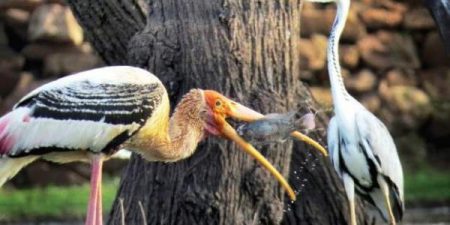Ankasamudra Bird Conservation Reserve 21/05/2019 – Posted in: Daily News – Tags: Ankasamudra Lake, Conservation Reserves, Wildlife Protection Act
ANKASAMUDRA BIRD CONSERVATION RESERVE
For: Preliminary
Topic covers: Bird Reserve, Reserve, Birds conservation
News Flash
Wildlife conservation activities, has written a letter to the Panchayat Chief Executive Officer urging him not to establish the eco-park near the conservation reserve and shift the proposal to another suitable place, apprehending that it would pose a threat to a wide variety of birds roosting and nesting there.
- Activists also apprehends that the establishment of the eco-park near the reserve would cause sound pollution, increase movement of people and the like which may lead to birds shifting from the reserve.
- State government declared the conservation reserve for birds in Ankasamudra and another for otters in the Tungabhadra river.
Ankasamudra Bird Conservation Reserve
- In Feburary 2017, Ankasamudra Lake has been declared a ‘Birds Conservation Reserve’ as per Section 36 A of the Wildlife Protection Act, 1972. This will be the first such reserve in the Hyderabad-Karnataka region.
- The reserve is the only one in the entire Hyderabad-Karnatak region, has been home to a wide variety of birds, both domestic and migratory.
- There are 175 species (of bird)and even 11 species from the International Union for Conservation of Nature Red List in and around Ankasamudra.
What makes it a reserve?
This has been declared as a reserve for its ecologicy, fauna, flora and geo-morphologic importance and for the purpose of protecting, propagating and developing wildlife or its environment and to protect the important breeding habitats of migratory birds and other local species.
Conservation Reserves
Conservation Reserves in India are terms denoting protected areas of India which typically act as buffer zones to or connectors and migration corridors between established national parks, wildlife sanctuaries and reserved and protected forests of India. Such areas are designated as conservation areas if they are uninhabited and completely owned by the Government of India but used for subsistence by communities.
Wildlife Protection Act, 1972
- It is an Act of the Parliament enacted for protection of plants and animal species.
- Before 1972, India only had five designated national parks.
- Among other reforms, the Act established schedules of protected plant and animal species; hunting or harvesting these species was largely outlawed.
- The Act provides for the protection of wild animals, birds and plants; and for matters connected therewith or ancillary or incidental thereto.
- It extends to the whole of India, except the State of Jammu and Kashmir which has its own wildlife act.
Source: The Hindu
You can follow us on LinkedIn and for more updates related to UPSC IAS Preparation, Like our Facebook Page and subscribe our Diligent IAS Youtube Channel
Also Read Related Daily News
- Redefined Units of Kilogram, Kelvin, Mole and Ampere across the World
- United Nation Human Rights Council (UNHRC)

